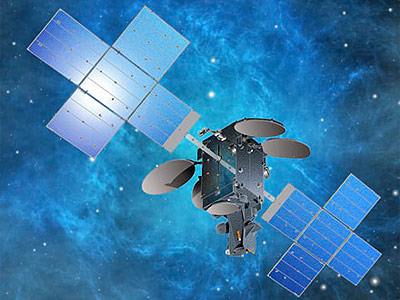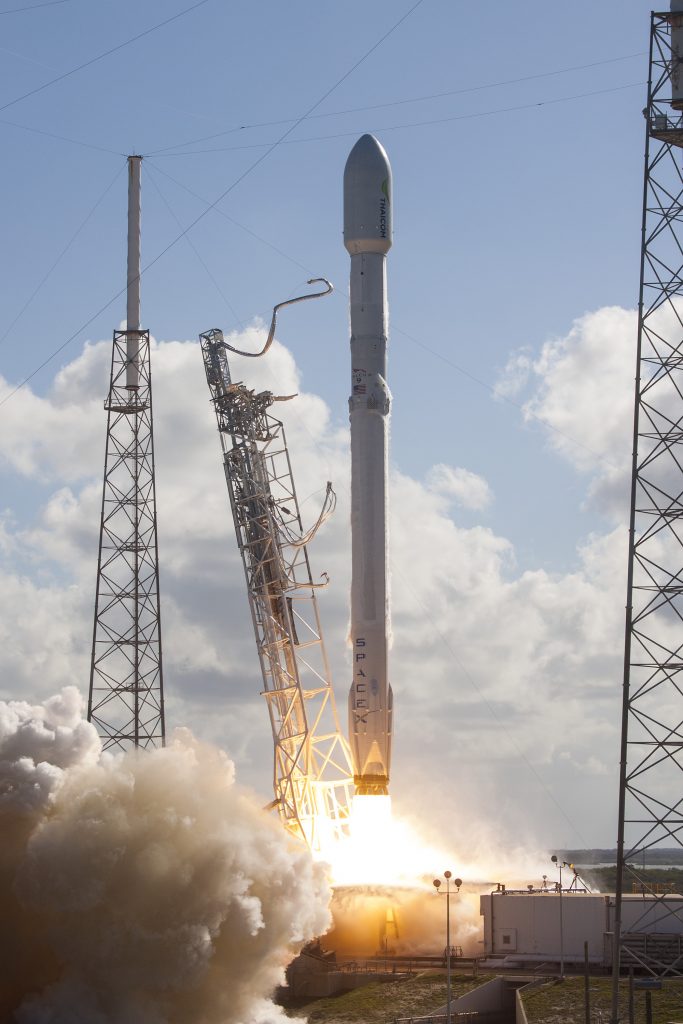SpaceX is targeting a Falcon 9 launch of the Hispasat 30W-6 satellite to a Geostationary Transfer Orbit (GTO) on Tuesday, March 6 from Space Launch Complex 40 (SLC-40) at Cape Canaveral Air Force Station, Florida. The two-hour launch window opens at 12:33 a.m. EST, or 5:33 UTC, with a two-hour backup launch window opening on Wednesday, March 7 at 12:33 a.m. EST, or 5:33 UTC.
The Hispasat 30W-6 satellite will be deployed approximately 33 minutes after launch. SpaceX will not attempt to land Falcon 9’s first stage after launch due to unfavorable weather conditions in the recovery area off of Florida’s Atlantic Coast.
 |
|
Launch date:
|
March 6, 2018
Launch Window Opens:
|
12:33 a.m. EST/05:33 UTC
Launch Window Closes:
|
2:33 a.m. EST/7:33 UTC
Backup Launch Window (2 hours):
|
Wednesday, March 7 (12:33 a.m. EST/5:33 UTC to 2:33 a.m. EST/7:33 a.m. UTC)
Launch site:
|
SLC-40, Cape Canaveral Air Force Station
{colsp=2}
[highlight]L[eventtimer]2018-03-06 05:33:00;%c%%ddd%/%hh%:%mm%:%ss%[/eventtimer][/highlight]
Mission Patch
Launch coverage:
[ame="https://youtu.be/Kpfrp-GMKKM"]HISPASAT 30W-6 Mission - YouTube[/ame]
Payload:

Hispasat 30W-6, formerly known as Hispasat 1F, is a multi-mission satellite built by SSL for Hispasat to provide service in Europe, North Africa, North America and South America. It will replace Hispasat 1D at 30° West longitude and will provide service for television, broadband, corporate networks and other telecommunications applications.
Hispasat announced in July 2014 the contract with SSL to built the satellite. The payload multi-mission consists of:
- 48 Ku band transponders, which serve three coverage areas: Europe and North Africa, with coverage on the Iberian Peninsula, the Balearic Islands, the Canary Islands, the Azores, Cape Verde and Madeira; Mauritius, Morocco, Mediterranean countries in North West Africa and the large part of the European continent visible from 30º West; The Americas, with coverage from Canada to Patagonia, not including Brazil.; South America, with coverage over the large part of the continent, especially in Brazil.
- 6 Ka band beams, with coverage on the Iberian Peninsula, the Balearic and Canary Islands, North West Africa and South East and Central Europe.
- 1 Ka BSS band beam, with coverage centred in the Iberian Peninsula.
- 1 C band beam, with coverage centred in Brazil.
Hispasat 30W-6 is based on the SSL-1300 satellite platform that provides the flexibility for a broad range of applications and technology advances. Scheduled for launch in 2017, the satellite is designed to deliver service for 15 years or longer.
Specifications
Type / Application:|
- Communication)
Operator:|
- Hispasat
Contractors:|
- Space Systems/Loral (SS/L)
Equipment:|
- 48 Ku-band transponders
- 6 Ka-band transponders
- 1 Ka-BSS-band transponder
- 1 C-band transponder
Configuration:|
Propulsion:|
- 4 × SPT-100 plasma thrusters
Power:|
- 2 deployable solar arrays
- Batteries (11.5 kW)
Lifetime:|
- 15 years
Mass:|
- 6092 kg
Orbit:|
- GEO
Launch Vehicle:
Falcon 9 FT represents an evolved version of SpaceX’s Falcon 9 v1.1 rocket incorporating a number of performance enhancements to enable the launch vehicle to lift heavy satellites to Geostationary Transfer Orbit while preserving the option of re-using the first stage. Operated by Space Exploration Technologies, the rocket represents the third evolutionary stage of the Falcon 9. The Falcon 9 Full Thrust (FT) vehicle is also known as ‘Falcon 9 Upgrade,’ ‘Enhanced Falcon 9,’ ‘Full Performance Falcon 9’ and ‘Falcon v1.2.’
The Falcon 9 FT launch vehicle is based on the Falcon 9 v1.1 (F9R) which in turn built on the original Falcon 9, retrospectively known as the v1.0 version of the rocket. Falcon 9 v1.0 was inaugurated in 2010 and flew successfully five times until 2013 when it was succeeded by the v1.1 version of the launcher. Falcon 9 v1.1 is retired after 15 missions, one of which was a failure. The v1.1 version itself was subject to a stepwise evolution, notably the implementation of reusability technologies on its first stage. These systems, among other changes, are standard on the Falcon 9 FT that premieres in late 2015 and is likely the final version of Falcon 9 with the maximum possible performance.

The Falcon 9 Full Thrust launch vehicle retains the overall design of the previous Falcon 9 rockets as a two-stage-to-orbit launch vehicle. Its first stage includes all systems necessary for an operational re-use of stages while the second stage is operated as an expendable rocket stage.
Falcon 9 FT stands 70 meters tall, is 3.66 meters in diameter and has a launch mass of 549,054 Kilograms. Both stages use sub-cooled Liquid Oxygen and chilled Rocket Propellant 1 as propellants consumed by Merlin 1D engines, nine of which are installed on the first stage while the second stage hosts a single Merlin 1D engine optimized for operation in vacuum.
SpaceX lists the payload capability of the Falcon 9 FT as 22,800 Kilograms to Low Earth Orbit and 8,300kg to Geostationary Transfer Orbit – these figures are for the fully expendable configuration of the vehicle. Leaving sufficient propellant margin for the return of the first stage to the Autonomous Spaceport Drone Ship for later re-use cuts the payload mass to GTO to around 5,500 Kilograms.
To achieve an operational re-usability of Falcon 9 first stages, all Falcon 9 FT rockets are outfitted with a reaction control system, four grid fins for steering and four deployable landing legs. Dropping the second stage off on its way to orbit, the first stage goes through a series of complex propulsive maneuvers before guiding itself through the atmosphere towards a target landing site for a soft touchdown under the power of one of its Merlin engines to be re-used on a future flight.
Specifications
Height:|
- 70m
Diameter:|
- 3.66m
Launch Mass:|
- 549,054kg
Stages:|
- 2
Boosters:|
- None
Mass to LEO:|
- 22,800 kg
Mass to GTO:|
- 8,300 kg
Mass to Mars:|
- 4,020 kg
Launch Cost:|
- $62M
L-1 Weather Forecast Patrick Air Force Base
Weather: None
Surface Visibility: 7 miles
Solar Activity: Low
Liftoff Winds (MPH): 110° @ 8-12 (200’)
Pressure: 30.02 inHg
Temperature: 60°F
Relative Humidity: 90%
Launch day probability of violating launch weather constraints: 10%
Primary concern(s): Thick Cloud Layers Rule
Delay day probability of violating launch weather constraints: 60%
Primary concern(s): Cumulus Cloud Rule, Thick Cloud Layers Rule
Latest launch day weather forecast is available here.
Links:
